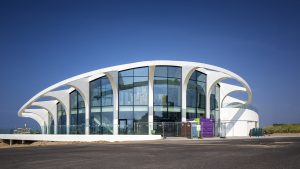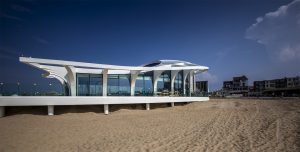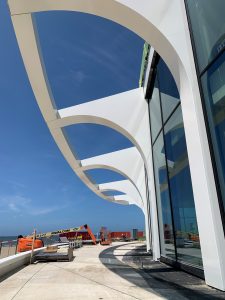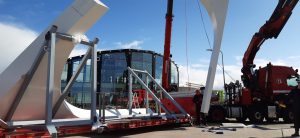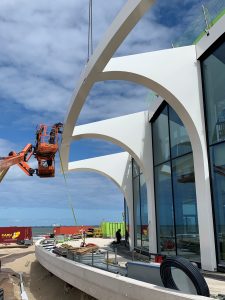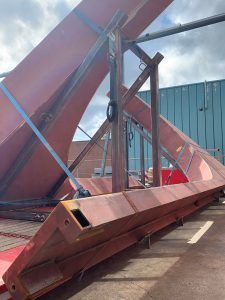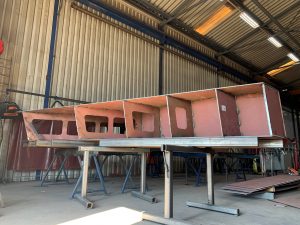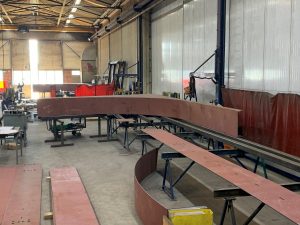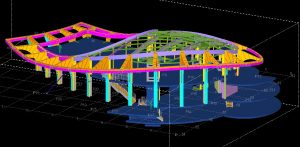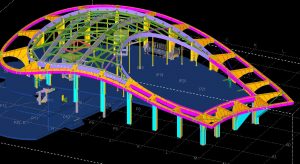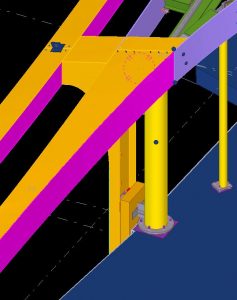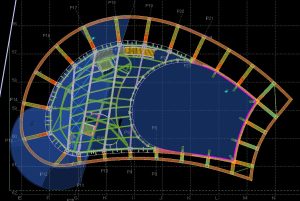Pavilioen Scheveningen

| Kategorie | Kommerzielle Projekte |
|---|---|
| Jahr | 2021 |
| Land | Benelux |
| Organisation | Vic Obdam Staalbouw bv. |
| Projektpartner | J.P. van Eesteren B.V. (Gouda), Wolter tijdink, CIG, Royal HaskoningDHV |
| Verfasser | Dilu Beenker |
| Auftraggeber | J.P. van Eesteren B.V. (Gouda) |
| Ort des Bauwerkes | Scheveningen |
| Tags |
GOLF VANUIT ZEE
Op het strand in Scheveningen, ter hoogte van de keerlus aan het eind van de Gevers Deynootweg, heeft J.P. van Eesteren een iconisch strandpaviljoen met drie verdiepingen gerealiseerd. Het ontwerp is van Bureau voor Stedebouw en Architectuur Wim de Bruijn BV en is geïnspireerd op de vormen van het strand en de zee. De bestemming? Een uniek entertainment attractiepunt als het begin van de nieuwe boulevard op Scheveningen.’
3D MAAKT HET MOGELIJK
In het oorspronkelijke ontwerp was de kroon -ofwel de sierconstructie van het paviljoen uitgevoerd in hout. In verband met mogelijke conserveringsproblemen besloot het team van Wim de Bruijn deze keuze te heroverwegen. Na een gesprek met Pieter Klijn van Vic Obdam Staalbouw was het team om: de kroon zou van staal worden. ‘Voor het realiseren van dit soort opdrachten is lef en veel ervaring nodig. Wij werken met een geweldig team van specialisten. Door hun expertise te bundelen en moderne technieken te gebruiken, komen we tot de mooiste resultaten. Met behulp van 3D-tekenen hebben wij de kroon volledig in kaart kunnen brengen en dankzij onze 3D-printer zelfs fysiek kunnen testen. Handig voor de architect en voor het verder perfectioneren van de verbindingen. Dit heeft geresulteerd in een constructie waar geen water in blijft staan, waarmee het risico op corrosie sterk gereduceerd is,’ vertelt directeur Pieter Klijn.
AL TIJDENS ONTWERP NADENKEN OVER UITVOERING
‘De architect gaf in het begin van onze samenwerking al aan dat hij de bevestigingspunten onzichtbaar wilde uitvoeren, vertelt projectleider Rick de Keijser. ‘Door dit soort wensen in een vroeg stadium aan te geven, is er nog van alles mogelijk, daarom denken we graag al in de ontwerpfase mee over de uitvoering. De onzichtbaarheid van de bevestigingen werd dus een van onze uitgangspunten. Evenals de duurzaamheid van de kroon en natuurlijk de esthetische kant van deze sierconstructie.’ ‘Dit was voor ons een bijzonder project. Alle onderdelen van de kroon zijn uniek en door zijn totaliteit zeer complex. Daarnaast was door de vorm een reguliere uitvoering met behulp van walsbewerking onmogelijk, daarom hebben we alle onderdelen met een drukpers gerealiseerd. Dankzij de 3D-technieken -ook de 3D-meettechniek die we zowel in de fabriek als op de bouwplaats hebben ingezet- is de uitvoering perfect verlopen.’
BIM samenwerking
De staalconstructie van het gebouw met het gewelfde dak en de glooiende borstwering op het dak terras is getekend in Tekla. Voor de engineering is met meerdere partijen samengewerkt. Zo zijn de trappen via modelsharing uitgewerkt door Wolter Tijdink. Het uitwerken van sierkroon van gekromde spanten die rondom het gebouw staan is in Rhino gedaan door CIG. Het model van de spanten is vervolgens via 3D dwg aan het tekla model toegevoegd.
WAVE FROM THE SEA
On the beach in Scheveningen, near the turning loop at the end of the Gevers Deynootweg, J.P. van Eesteren has realised an iconic three-storey beach pavilion. The design is by Bureau voor Stedebouw en Architectuur Wim de Bruijn BV and is inspired by the shapes of the beach and the sea. The destination? A unique entertainment attraction point as the beginning of the new boulevard at Scheveningen‘.
3D MAKES IT POSSIBLE
In the original design, the crown ornamental structure of the pavilion was made of wood. Because of possible preservation problems, Wim de Bruijn’s team decided to reconsider this choice. After a conversation with Pieter Klijn of Vic Obdam Staalbouw, the team was convinced: the crown would be made of steel. It takes guts and a lot of experience to realise this kind of project. We work with a great team of specialists. By combining their expertise and using modern techniques, we achieve the best results. Using 3D drawing, we have been able to fully map out the crown and, thanks to our 3D printer, even physically test it. Useful for the architect and for further perfecting the connections. This has resulted in a construction in which no water remains, greatly reducing the risk of corrosion,‘ says director Pieter Klijn.
THINKING ABOUT IMPLEMENTATION DURING THE DESIGN PHASE
The architect indicated at the start of our collaboration that he wanted the fastening points to be invisible,‘ says project manager Rick de Keijser. By stating such wishes at an early stage, anything is still possible, which is why we like to think about the implementation right from the design phase. The invisibility of the fasteners therefore became one of our starting points. Just like the durability of the crown and, of course, the aesthetic aspect of this decorative construction. This was a special project for us. All the components of the crown are unique and, as a whole, very complex. In addition, the shape of the crown made it impossible to produce it in the usual way using roll-forming, so we used a printing press for all the parts. Thanks to the 3D techniques – including the 3D measuring technique that we used both in the factory and on site – the execution went perfectly.
BIM Collaboration
The steel structure of the building with the arched roof and the sloping parapet on the roof terrace was drawn in Tekla. For the engineering, we worked together with several parties. The stairs, for example, were worked out through model sharing by Wolter Tijdink. CIG worked out the decorative crown of curved trusses around the building in Rhino. The model of the trusses was then added to the tekla model via 3D dwg.

